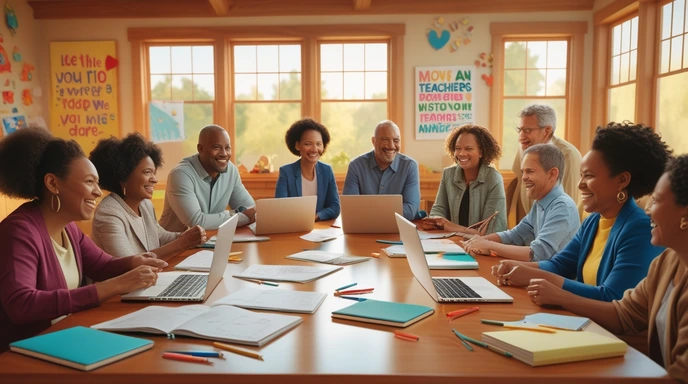The journey of a child’s education is a collaborative effort, a tapestry woven from the threads of home and school life. The cornerstone of this partnership? Parent-teacher collaboration. But why is this connection so vital, and how does it transform a student’s experience? This article explores how the alliance between parents and educators dramatically enhances student performance, fostering not just academic gains but also social-emotional growth and a lifelong love of learning. We will delve into the profound impact of working together and explore effective ways to bridge any communication gaps.
Table of Contents
Why is Parent-Teacher Collaboration So Crucial?
A Unified Front for Student Success
Think of a student’s learning journey as a three-legged race. When parents, teachers, and the student are working together in sync, the progress is smooth and swift. However, if one leg is out of step, the journey becomes significantly more challenging. Parent-teacher collaboration ensures that everyone is on the same page 🤝, working together to support the child’s development. It means aligning goals, sharing insights, and providing a consistent message that bolsters a student’s confidence and drive.
More Than Just Academics: Holistic Development
Effective collaboration extends beyond just report cards and homework assignments. It encompasses a student’s entire being – their social skills, their emotional well-being, and their overall approach to learning. When parents and teachers communicate openly, they can identify potential challenges early on and develop strategies to nurture the student’s holistic development. It’s about creating a nurturing environment 🏡 where a child can feel safe, supported, and empowered to reach their full potential.
The Ripple Effect: Benefits of Parent-Teacher Partnerships
The positive consequences of parent-teacher collaboration are far-reaching, impacting various aspects of a student’s life both within and outside the classroom.
Academic Excellence: Grades and Beyond
Research consistently demonstrates that when parents are actively involved in their child’s education, academic outcomes improve significantly. Students with engaged parents tend to achieve higher grades, exhibit stronger problem-solving skills, and have a deeper understanding of the subject matter 📈. This goes beyond rote memorization, fostering a genuine passion for learning. The National Child Development Study (NCDS) found that children with very interested parents progress 15-17% more in math and reading between 11-16 years old.
Social-Emotional Growth: Building Confidence and Resilience
Beyond academics, parent-teacher partnerships are vital in nurturing a child’s social and emotional intelligence. Students often feel more confident, secure, and resilient when they know their parents and teachers are working together to support them 😊. This collaboration helps children develop better communication skills, build stronger relationships with peers, and navigate challenges effectively. As noted by the Harvard Family Research Project, these partnerships are associated with better social behavior.
Improved Attendance and Engagement
When students witness a strong bond between their parents and teachers, their attendance rates improve, and they demonstrate greater enthusiasm for learning 📚. They are more likely to engage in classroom discussions, participate in school activities, and approach learning with a positive attitude. A report by the Annie E. Casey Foundation indicated that the better the partnership between school and home, the better the school and the higher the student achievement across the board.
Bridging the Gap: How to Foster Effective Communication
Effective communication is the bedrock of successful parent-teacher collaboration. It involves creating a clear, open, and two-way dialogue between parents and teachers, respecting each other’s perspectives and sharing relevant information.
Open and Honest Dialogue
Building a strong parent-teacher relationship requires mutual respect and trust. Starting with positive interactions and focusing on the child’s strengths creates a foundation for open communication. Active listening is crucial. Teachers should listen to parents without interruption, validating their feelings and opinions. Similarly, parents should be open to feedback and suggestions from teachers. This open and honest dialogue 💬 allows for a more effective partnership.
Leveraging Technology for Seamless Communication
In today’s digital age, technology offers various avenues for effortless communication. Educational apps, email, and online platforms can keep parents informed about their child’s progress, upcoming events, and classroom activities. Leveraging tools like parent portals or messaging apps can streamline communication and allow for more timely updates 📱.
Creating a Welcoming Environment for All
Schools play a pivotal role in fostering inclusive environments where all parents feel welcome, valued, and comfortable participating in their child’s education. Cultural sensitivity and acknowledging diverse family structures are essential components of building strong relationships. It is helpful to initiate contact early in the school year and to use various communication methods that are accessible for all families.
Challenges on the Path to Collaboration
While the benefits of parent-teacher collaboration are undeniable, several challenges can hinder effective partnerships. Recognizing and addressing these obstacles is crucial to building a more robust collaborative environment.
Time Constraints and Scheduling Conflicts
Both parents and teachers often face demanding schedules, which can make finding time for meaningful communication difficult. Work commitments, childcare responsibilities, and extracurricular activities can limit parents’ ability to attend meetings or engage in school-related activities. Teachers, too, are often juggling large class sizes and multiple responsibilities, leaving little room for individual communication with parents. Flexibility and using various communication methods to work around these challenges is essential.
Communication Barriers: Language and Culture
Language and cultural differences can pose significant challenges to parent-teacher communication. When parents and teachers don’t speak the same language or come from different cultural backgrounds, it can be difficult to establish a shared understanding and build trust. Schools should strive to provide interpretation services and create culturally sensitive communication strategies to address these barriers 🌍.
Differing Perspectives and Expectations
Parents and teachers might have different expectations and perspectives on education, which can sometimes lead to misunderstandings or conflict. Some parents might prefer a more traditional approach to learning, while teachers might advocate for more student-centered methods. Open dialogue and mutual respect are crucial to bridge these differences and ensure a collaborative approach. A recent study from the University of Pretoria revealed that teachers and parents sometimes did not know how to work together, and that teachers needed training in order to work with parents.
The Path Forward: Cultivating Stronger Partnerships
Overcoming the challenges and building a successful parent-teacher partnership requires a proactive approach from both sides. Teachers need to create opportunities for meaningful engagement and communication, while parents need to be empowered to take an active role in their child’s educational journey.
Proactive Strategies for Teachers
Teachers can initiate communication early in the school year, establishing positive rapport with parents. Regular updates, both positive and constructive, can keep parents informed about their child’s progress. Be prepared to communicate by creating a list of specific areas you would like to discuss beforehand. Teachers should also make it a priority to be active listeners during these communications and create a space that feels safe and welcoming. The NSW Department of Education suggests discussing a student’s strengths first and encouraging active participation.
Empowering Parents to Take an Active Role
Parents can contribute to their child’s education in many ways. Attend parent-teacher conferences and school events, volunteer in the classroom, and create a supportive home learning environment. Parents can also advocate for their children by becoming knowledgeable about school operations and policies. Parents should feel confident in working with schools and should expect the best for their children. The National PTA notes that families from all backgrounds can positively impact their children’s success.
Nurturing Success: The Enduring Value of Parent-Teacher Collaboration
The evidence is clear: parent-teacher collaboration is not just a nice-to-have; it’s a necessity for student success. When parents and teachers work as a unified team, students experience a positive transformation—not just in academics but also in their overall well-being and confidence. These partnerships create a network of support that ensures every child has the opportunity to thrive and reach their full potential. By fostering open communication, embracing diversity, and addressing challenges with empathy, we can build stronger parent-teacher relationships that pave the way for a brighter future for every student. The impact of this collaboration resonates far beyond the classroom, shaping well-rounded, confident, and successful individuals.

